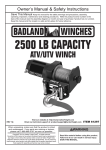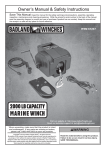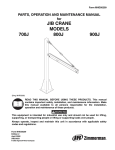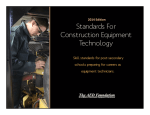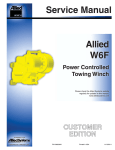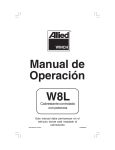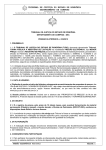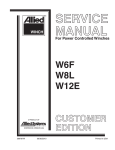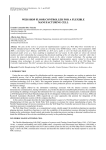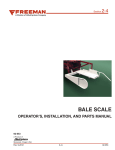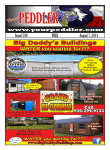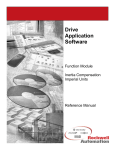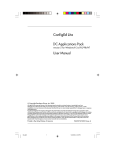Download 599024W - Allied Systems Company
Transcript
This manual must be with the vehicle on which this winch is installed. Please check the Allied Systems website regularly for updates to this manual. www.alliedsystems.com P/N 599024W 02/22/2013 Winch Model Date Delivered H5C & H6G Serial Number Date Installed Special Equipment or Attachments A Product of Allied Systems Company Sherwood, Oregon USA 02/22/2013 Printed in USA Foreword Foreword The safe and efficient operation of a winch requires skill and alertness on the part of the operator. To develop the skills required, the operator must: • • • • Receive training in the proper operation of the winch and the machine on which it is mounted. Understand the capabilities and limitations of the winch and the machine on which it is mounted. Become familiar with the winch and the machine on which it is mounted and see that they are maintained in good condition. Read and understand the SAFETY SUMMARY and OPERATING PROCEDURES contained in this Operating Manual. In addition, a qualified person experienced in the operation of the winch must guide a new operator through several load handling applications before the new operator attempts to operate the equipment alone. It is the employer’s responsibility to make sure that the operator can see, hear, and has the physical and mental ability to operate the equipment safely. This Operating Manual contains basic information necessary for the operation and maintenance of a winch. Optional equipment is sometimes installed that can change the characteristics described in this manual. Make sure the necessary instructions are available and understood before operating the winch. Some of the components described in this Operating Manual will NOT be installed on your winch. If you have questions about any item on your winch or described in this Operating Manual, contact your local winch dealer, or contact Allied Systems Company: Allied Systems Company 21433 SW Oregon Street Sherwood, OR 97140 USA Phone: 503-625-2560 Fax: 503-625-7269 E-Mail: [email protected] Also visit our website, www.alliedsystems.com, where the most current copy of this manual is always available. i NOTE: For repairs and overhaul, contact your Allied winch dealer. If you maintain your own equipment, a service manual is available for your specific winch. ii NOTE: This publication may be translated to different languages for sole purpose of easy reference in non-English speaking locations. Should there be differences in interpretations to the text, please refer to the English language edition published by Allied Systems Company as the controlling document. Contents Contents Foreword .................................................................. i Contents ................................................................. iii Safety Summary ..................................................... v General Introduction ...............................................................1 How Winches Operate ..............................................1 Nameplate ................................................................5 Cable Selection ........................................................6 Oil Selection & Capacity ..........................................8 H5C & H6G Winch Description ...............................10 Optional Equipment ................................................12 Serial Number Codes .............................................14 Operation Checks Before Operation .......................................19 Checks During Operation .......................................19 Operating Procedures ............................................20 FREESPOOL Operation.........................................23 FREESPOOL Drag Adjustment.......................23 HI-SPEED Operation ..............................................24 HI-TEMP SHUT OFF OVERRIDE Operation .........25 Winch Troubleshooting Chart .................................26 Maintenance Maintenance ...........................................................27 Maintenance Points ..........................................27 Maintenance Schedule ....................................28 Operating Techniques Tractor or Skidder Operation ..................................31 How To Move A Disabled Vehicle............................34 Working on A Steep Slope .....................................36 Tractor Is Down The Slope ...............................36 Other Equipment Is Down The Slope ...............37 Operational Differences, Optional Equipment Integral Arch ...........................................................39 Fairlead ...................................................................39 Drawbar ..................................................................40 Optional Gear Ratios ..............................................40 iii Intentionally Blank iv Safety Summary Safety Summary General Safety Notices The following pages contain general safety warnings which supplement specific warnings and cautions appearing elsewhere in this manual. All electrical and hydraulic equipment is dangerous. You must thoroughly review and understand the Safety Summary before attempting to operate, troubleshoot or service this winch. The “WARNING” symbol appears wherever incorrect operating procedures or practices could cause serious injury or death. Carefully read the message that follows to prevent serious injury or death. The following symbols/terms are used to emphasize safety precautions and notices in this manual: DANGER The “DANGER” symbol indicates a hazardous situation which, if not avoided, will result in death or serious injury. Carefully read the message that follows to prevent serious injury or death. The “CAUTION” symbol appears where a hazardous situation which, if not avoided, could result in minor to moderate injury and equipment damage. v This signal word alerts to a situation that is not related to personal injury but may cause equipment damage. NOTE: … The term “NOTE” highlights operating procedures or practices that may improve equipment reliability and/or personnel performance. Safety Regulations Each country has its own safety legislation. It is in the operator’s own interest to be conversant with these regulations and to comply with them in full. This also applies to local bylaws and regulations in force on a particular worksite. Should the recommendations in this manual deviate from those in the user’ country, the national regulations should be followed. vi The winch shall not be used for hoisting. Use hearing protection when operating winches. Maximum winch system permissible pressure: 650 PSI - Control Pressure 3,500 PSI - Working Pressure. NOTE: All possible safety hazards cannot be foreseen so as to be included in this manual. Therefore, you must always be alert to potential hazards that could endanger personnel and/or damage the equipment. Safety Summary Operation, Inspection, and Maintenance Warnings • • Inspect the winch before each use: » Obey the following cautions and warnings before using your winch to avoid equipment damage, personal injury or death. Do not operate the winch unless you are authorized and trained to do so. Make sure that the controls and instruments operate correctly. » Report the need for repairs immediately. » Do not work with a damaged or worn wire rope. » Do not use a winch that needs repairs. » If the wire rope and ferrule must be removed from the drum, make sure the end of the wire rope and ferrule are controlled when the ferrule is released. The end of the wire rope can suddenly move from the drum like a compressed spring when the ferrule is released and cause an injury. Stay in the operator’s seat when operating the winch. • Do not operate the winch unless the vehicle is equipped with a screen to protect the operator if the wire rope breaks. • Read, understand, and follow the operating, inspection, and maintenance instructions in this Operating Manual. • Do not use the control levers for hand holds when entering or leaving the vehicle. • • Do not permit other people near the control area when you inspect or repair a machine. • Do not stand on the vehicle when operating the winch. • Never inspect, repair, or perform maintenance on a machine that is in motion. • Avoid winch operation near people or other machines. vii • Never stand nor permit others to stand in the bight (loop) of a wire rope. • Do not stand nor permit others to be near the winch or wire rope when there is tension on the wire rope. • Observe jobsite rules. • Be in complete control at all times. • Do not use the control levers as hangers for clothes, water bags, grease guns, lunch pails, etc. • Do not leave the vehicle when the winch wire rope is under tension. • Do not permit riders on the vehicle or load. • Do not use the winch as an anchor for a double or two-part line. • Do not pull the hook through the throat or over the drum, which will cause damage. • When the winch is not in use, make sure the control lever is in BRAKE-ON position and the winch brake is applied. viii • Do not use winch as a hoist. Tractor and skidder mounted winches are designed for towing. • Always inspect wire rope, tail chain and other rigging components for wear, damage, broken strands or abuse before use. • Never use wire rope, tail chain or other rigging that is worn-out, damaged or abused. • Never overload wire rope, tail chain or rigging. Safety Summary • Wire rope and tail chain will fail if worn-out, overloaded, misused, damaged, improperly maintained or abused. Wire rope or tail chain failure may cause serious injury or death! KG • Make sure ground personnel are in plain view of the operator, and at a distance of at least 1½ times the working length of the wire rope. • Make sure that any hand signals used by ground personnel are clearly defined and understood by everyone involved. • Do not attempt to “jerk” or “shock” a load free. Doing so can cause loads in excess of the rated capacity of the wire rope, winch, or mounting hardware. • Replace any parts only with genuine Allied Winch parts. Refer to Parts Manuals 599029W for H5C winch and 599027W for H6G winch. • Maintain a minimum of three (3) complete wraps of wire rope on the drum for normal operation. It may help to paint the last five wraps of wire rope a contrasting color, to serve as a visual indicator. • Do not handle wire rope with bare hands. Wear leather gloves at all times. KG • Do not terminate wire rope to tail chain by the use of a knot. • Do not handle wire rope if the hook end is not free. A load could break away, suddenly tensioning the wire rope, resulting in serious injury or death. • Stay clear of wire rope entry areas (fairlead or arch rollers, winch drum etc). ix • Align the tractor with the load to prevent side loading the winch, and to maintain even spooling of the wire rope. • If applying tension to the wire rope manually during spooling: » » • • x ensure that the operator is winching in slowly, keep your hands and clothing well clear of any rollers or the winch drum, » do not maintain tension by letting the wire rope to slip through your hands, » use a hand-over-hand technique to maintain tension. Be aware of the ground conditions, and make sure the ground and tractor are stable enough to pull the intended load. Do not attempt to pull loads in excess of the rated capacity of the winch. • Keep yourself informed of any applicable codes, regulations and standards for the job. • Your winch may have temperature shut-off system for protection of tractor and winch. Manual override of high temperature shut-off will cause damage to tractor and winch. • This winch is neither intended, designed, nor rated for any application involved in the lifting or moving of personnel. • Use only the lubricants listed in the Recommended Oil List. See Pages 8 and 9. • Do not weld on any part of the winch. Contact Allied Systems if weld repairs are needed. • The hydraulic system must be kept clean and free of contamination at all times. Safety Summary • Be aware of the hazards of pressurized hydraulics: » » » » » Wear personal protective equipment, such as gloves and safety glasses, whenever servicing or checking a hydraulic system. Assume that all hydraulic hoses and components are pressurized. Relieve all hydraulic pressure before disconnecting any hydraulic line. Never try to stop or check for a hydraulic leak with any part of your body; use a piece of cardboard to check for hydraulic leaks. Small hydraulic hose leaks are extremely dangerous, and can inject hydraulic oil under the skin, even through gloves. Infection and gangrene are possible when hydraulic oil penetrates the skin. See a doctor immediately to prevent loss of limb or death. xi Notes xii General General Introduction This Operating Manual contains basic information necessary for the operation and maintenance of the H5C and H6G winches. How Winches Operate 1. Operating Principles of Winches for Caterpillar D6N (C81), PL61 (C391), John Deere 750J/850J (E47), 750J (E48), and Komatsu D61-15EX (K47) Tractors A winch is normally installed on a skidder or tractor to: • increase the pulling power of the skidder or tractor. • reach into an area where a skidder or tractor cannot go. • make lift functions available when special attachments are installed. The winch is powered by an internal hydraulic motor connected to the tractor hydraulic system. Oil flow and pressure are converted to rotational energy by the winch motor. On the H6G, torque is transmitted through a holding brake, a planetary speed reducer and two gear reductions to the drum. On the H5C, torque is transmitted through a holding brake, and three gear reductions to the drum. Hydraulic oil is supplied by the tractor mounted pump. The winch utilizes oil, filtration and cooling provided by the tractor circuit. Power to the winch is controlled by a control lever and electrical switches located at the tractor’s control station. The tractor must be running, and the auxiliary hydraulic function switch, if equipped, must be on. LINE-IN, LINEOUT and BRAKE-ON are controlled by a proportional control lever. When the control lever is in the BRAKE-ON or centered position, the holding brake is automatically applied. Pushing the lever away from the operator releases the brake and reels wire rope off the drum (LINE-OUT). Pulling the lever towards the operator releases the brake and reels wire rope onto the drum (LINE-IN). Releasing the lever causes it to return to the BRAKE-ON position, which stops the drum rotation and applies the holding brake. Moving the lever a small amount results in slow wire rope movement for inching control. Line speed increases proportionally as the lever is moved farther. 1 The switch panel may contain up to four rocker switches to control FREESPOOL, BRAKE-OFF, HI-SPEED and HI-TEMP SHUT OFF OVERRIDE. Not every winch is equipped with all four. A light shows when a switch is on, except for HI-TEMP SHUT OFF OVERRIDE. The FREESPOOL, BRAKE-OFF and HI-TEMP SHUT OFF OVERRIDE switches incorporate a lock to prevent inadvertent actuation. The slide lock must be released before the switch can be turned on. BRAKE-OFF is available as an option only to High-Performance winches. The HI-TEMP SHUT OFF OVERRIDE feature is available as an option to both Rescue and High-Performance winches. The tractor must be running to supply hydraulic power to operate these functions. FREESPOOL should not be used if there is a load on the wire rope. An uncontrolled release of the load will occur. Loss of the load can result in injury and/or equipment damage. 2 The yellow indicator panel on the selector switch lights when the winch is in FREESPOOL. If equipped with BRAKE-OFF, the red indicator in the BRAKE-OFF switch will also light even though that switch is in the off position. When FREESPOOL is selected, a hydraulically-actuated sleeve disengages the drum pinion from the intermediate shaft. The drum is now disconnected from the brake, and the winch cannot support a load. The control lever will still operate the winch motor, but the drum will not turn. When the BRAKE-OFF switch is selected, the holding brake is released, allowing the tractor to move away from a towed load. The tractor must be operated at a slow speed within the range of the first transmission setting. The HI-SPEED switch is a dual-action momentary switch. Pushing it towards the operator allows the winch to operate at low speed, while pushing the switch away from the operator activates HI-SPEED. When in HI-SPEED mode (green light on), the winch will automatically shift to low speed when the load exceeds a certain percentage of the rated load. For heavy loads or when better control is desired, the winch should be operated in the normal speed. For light loads and faster wire rope speed, operate the winch in HI-SPEED mode. General 2. Operating Principles of H5C High Performance Winches for Caterpillar D6K (C80) and Komatsu D51EX/ PX-22 (K37) Tractors The H5C High Performance winch is designed to operate on a hydrostatic, pilot operated hydraulic system. The winch has a high-pressure pump and motor similar to a hydrostatic transmission. The charge pump inside the main pump circulates oil to the filter, winch control valve, control lever, and charge circuit of the pump. Excess flow from the charge system is sent through the pump and motor for cooling. When the tractor is running, the winch is ready to operate but no oil is flowing to the winch motor. Pilot pressure is present at the winch control valve. A filter bypass indicator light is located near the winch operator controls. An illuminated filter bypass indicator light indicates either the oil is too thick or the filter should be replaced. If the oil is too thick, it is either too cold or an incorrect viscosity grade is being used. To warm cold oil, operate the tractor at a low to mid-throttle setting. The winch is ready to operate when the filter indicator light is not illuminated. The control lever and electrical switches are used to select the following operations: • • • • • • BRAKE-ON LINE-IN LINE-OUT HI-SPEED BRAKE-OFF FREESPOOL The operator must reset the switches to deactivate the FREESPOOL and BRAKE-OFF functions. The tractor mounted lever controls LINE-IN, LINE-OUT, HI-SPEED, and BRAKE-ON functions. When the lever is in the neutral or spring-centered position, the winch is in BRAKE-ON mode. In the BRAKE-ON position, no oil is directed to the motor and the spring-applied holding brake prevents drum movement, unless BRAKE-OFF or FREESPOOL are selected. When the operator selects the LINE-IN or LINE-OUT position, charge pressure is metered to the pump swash plate piston, motor swash plate piston, and to the winch brake release circuit. The operator chooses winch direction at the control lever and oil flow from the main pump is supplied to the motor. LINE-IN and LINE-OUT speed is proportional to lever movement. By moving the control lever to full stroke, HI-SPEED is activated. Charge pressure actuates the motor 3 swash plate to reduce motor displacement and increase motor rpm. If pressure in the main circuit exceeds a factory set level, the motor will automatically increase motor displacement to prevent motor stall. Motor stall will occur when the load exceeds winch capacity. When the control lever is returned to the BRAKE-ON position, the brake is automatically applied. In BRAKE-OFF, hydraulic pressure is applied to release the brake-off clutch. As wire rope is pulled from the winch, the turning drum back-drives the winch gear train to the brake-off clutch. The winch motor, brake, and planetary reducer remain stationary. Mechanical drag through the gear train and viscous drag in the brake-off clutch keep the wire rope from bird-nesting as it is spooled off the drum. When the BRAKE-OFF switch is selected, the brake-off clutch is disengaged, allowing the tractor to move away from a towed load. BRAKE-OFF is controlled by the rocker switch with a red indicator. A safety lock prevents the switch from accidentally being turned on. To operate the switch, slide the locking tab first, then push the rocker switch. FREESPOOL is controlled by the rocker switch with the yellow indicator. A safety lock prevents the switch from being accidentally turned on. To operate the switch, slide the locking tab, then push the rocker switch. FREESPOOL mechanically disengages the winch drum from the drive train so wire rope can be pulled from the winch by hand. When the FREESPOOL switch is turned on, the yellow indicator will light as well as the red indicator on the BRAKE-OFF switch. BRAKE-OFF mode is simultaneously activated in FREESPOOL to allow re-engagement of the gear train when FREESPOOL is turned off. The BRAKE-OFF position is used when there’s a load on the winch wire rope. It allows the operator to slowly move the tractor away from the load while spooling wire rope off the drum in a controlled manner. 4 General Nameplate Each winch is shipped from the factory with a nameplate as shown in Figure 1. The rated capacity for the winch, as it is equipped, is shown on the nameplate. Each winch must be operated within its rated capacity. If the nameplate is missing, or the wire rope does not match the information on the nameplate, do not operate the winch until its capacity is known. The serial number of your winch is stamped both into the nameplate and into the frame, as shown in Figures 7 and 8. Figure 1 - Nameplate 5 Wire Rope Selection Each winch model can have a variety of wire rope sizes installed by the user. The maximum wire rope size is shown on the nameplate. See Figure 2 and Figure 3 for approved wire rope sizes and drum capacities. When a larger diameter wire rope is used, the length of wire rope installed on the drum will be shorter. In some situations, the winch can create a tension in the wire rope that is greater than the strength of the wire rope. The user must be careful to select a wire rope that has enough strength and length for the job. During operation of the winch, the operator must know or estimate the line pull, and make sure that the line pull is within the capacity of the winch and the specifications of the wire rope installed on the drum. A broken wire rope under high tension can return suddenly in the direction of the winch and cause injury and damage. 6 The wire rope may disengage from the ferrule pocket if there is a load on the wire rope with fewer than 3 complete wraps on the drum. This will cause a loss of load and possible injury. When spooling wire rope from the drum, it is very difficult for the operator to know when nearing the end of the wire rope. It is recommended that the last 5 wraps of wire rope be painted a contrasting color to alert the operator that the end of the usable wire rope has been reached. Wire Rope Diameter 16mm (5/8 in.) 19mm (3/4 in.) 22mm (7/8 in.) H5C Capacity 129 m (423 ft.) 91 m (298 ft.) 66 m (215 ft.) Note: Loosely or unevenly spooled line will change capacities. Use flexible cable with independent wire rope center. Figure 2 - H5C Drum Line Capacities General Wire Rope Diameter 19mm (3/4 in.) 22mm (7/8 in.) 25mm (1.0 in.) H6G Capacity (Drum: 10 in.) 121 m (399 ft.) 87 m (287 ft.) 68 m (223 ft.) Note: Loosely or unevenly spooled line will change capacities. Use flexible cable with independent wire rope center. H5C H6G Ferrule Size & Type Light Ferrule 2 1/4” x 2.0” Dia. Light Ferrule 2 1/4” x 2.0” Dia. Figure 4 - Ferrule Size and Type for H5C and H6G Figure 3 - H6G Drum Line Capacities 7 Oil Selection The main consideration while selecting hydraulic fluid is the estimated oil temperature extremes that will be expe- VISCOSITY GRADE ISO SAE VG 22 10W VG 32 15W VG 46 20 VG 68 20 VG 100 30 rienced during service so the most suitable temperatureviscosity characteristics are obtained. OIL OPERATING TEMPERATURE RANGE °F °C -5 to 140 -20 to 60 10 to 160 -12 to 71 20 to 180 -7 to 82 30 to 200 -1 to 93 40 to 220 4 to 104 TYPICAL AMBIENT TEMPERATURE RANGE °F °C -5 to 40 -20 to 4 10 to 55 -12 to 13 20 to 70 -7 to 21 30 to 90 -1 to 32 40 to 110 4 to 43 Figure 5 - Oil Selection Chart Factory fill is Exxon-Mobil 424, which has an ISO Viscosity Grade 46 to 68. 8 For external pump winches (the winch pump uses tractor hydraulic fluid) the hydraulic circuit and winch gear housing may have different fluids. Note that some hydraulic system oils are not recommended for use inside the winch. General For inside winch housing, use the following oils: HYDRAULIC SYSTEM (PUMP) WINCH CASE (GEAR TRAIN) Caterpillar Use Tractor Fluid TDTO TO-4 MTO John Deere Use Tractor Fluid Hy-Gard Komatsu Use Tractor Fluid Universal Tractor Fluid Chevron Use Tractor Fluid 1000 THF Exxon-Mobil Use Tractor Fluid Mobil Fluid 424 Case Use Tractor Fluid Hy-Tran Ultra New Holland Use Tractor Fluid Multitran Figure 6 - Recommended Oil List Oil Capacity The oil capacity for H5C winch is 17 quarts (16 liters). The oil capacity for H6G winch is 8.5 quarts (8 liters). 9 H5C and H6G Winch Descriptions 1. 2. 3. 4. 6. 7. Drum Access Cover for Motor and Winch Hydraulics Plug to Drain Oil Plug to Check Oil Level Tie Bar Fill Plug 9. 10. 11. 12. Bearing Retainer for Intermediate Shaft & FREESPOOL drag Adjuster Right Side Drum Shaft Drawbar (Not Shown) Breather Figure 7 - H5C Towing Winch 10 General 1. 2. 3. 4. 6. 7. Drum Access Cover for Motor and Winch Hydraulics Plug to Drain Oil Plug to Check Oil Level Tie Bar Fill Plug 9. 10. 11. 12. Bearing Retainer for Intermediate Shaft & FREESPOOL drag Adjuster Right Side Drum Shaft Drawbar (Not Shown) Breather Figure 8 - H6G Towing Winch 11 Optional Equipment The H5C and H6G winches may be equipped with the following options: NOTE: Not all optional equipment listed is available for each model of tractor. • • • • * See the nameplate for the max wire rope size with arch. Integral arch Fairlead assembly Heavy duty extended drawbar Optional gear ratios (for H6G winch) Integral Arch* Winch Fairlead Winch Figure 9 - Optional Equipment (H6G Shown) 12 General Intentionally Blank 13 Serial Number Codes The nameplate with the serial number code is found on the left front corner of the winch case. A serial number indicates the following information: H5C H 1 E 1501 C80 Winch Model Vehicle Code H5C was previously known as WH5C. The "W" designation has been dropped for simplicity. See Figure 10 Sequence Number Hydraulic Operation Type H = High Performance (Hydraulic or Hydrostatic with 2-Speed & BRAKE-OFF) T = Rescue (Tractor Direction Spool, Single Speed) Gear Ratio Code 1 = 45:1 2 = 48:1 14 Internal Options External Pump, PFR, FS & Overwind = E External Pump, PFR, FS & Underwind = U Notes: 1. 2. In Addition to the serial number plate, the serial number is stamped on the top left-hand side of the frame. Circled numbers in Figure 10 indicate possible gear ratios. General Tractor Make Model and Starting Tractor Serial Number Where Applicable C O D E A C E H K R New Holland & Fiat Caterpillar John Deere Dressta Komatsu Case D51-22 37 39 700J 48 750J D6K 80 391 PL61 Figure 10 - Tractor or Skidder Identification Codes and Available Gear Ratios for H5C Winch 15 H6G H 1 B 1501 C81 Winch Model Vehicle Code H6G was previously known as WH6G. The "W" designation has been dropped for simplicity. See Figure 11 Sequence Number Hydraulic Operation Type H = High Performance: Winch Direction Valve, variable or 2 Speed T = Rescue: Tractor Direction Valve, Single Speed Gear Ratio Code 1 = 60:1 2 = 75:1 3 = 70:1 4 = 88:1 Internal Options Eternal Pump, PFR, FS, BRAKE-OFF Clutch = B External Pump, PFR, FS = E (Early Units had Hydraulic BRAKE-OFF Where Motor Rotated) External Pump, PFR, FS = J (with CARC Green Paint & 50mm Dia Pin Drawbar; without Tractor Side Installation Parts) Notes: 1. 2. 16 In Addition to the serial number plate, the serial number is stamped on the top left-hand side of the frame. Circled numbers in Figure 11 indicate possible gear ratios. General Tractor Make Model and Starting Tractor Serial Number Where Applicable C O D E A C E H K R New Holland & Fiat Caterpillar John Deere Dressta Komatsu Case 47 750J/850J 48 81 D61EX-15 750J D6N Figure 11 - Tractor or Skidder Identification Codes and Available Gear Ratios for H6G Winch 17 Intentionally Blank 18 Operation Operation Checks Before Operation Checks During Operation Check the wire rope and hook for wear or damage. Check that the periodic inspection and maintenance have been done at the recommended operating hours. See Figure 18, the Maintenance Schedule, on page 29. The Troubleshooting Chart, Figure 15, on page 26 can be used by the operator to identify a problem with the winch operation. A trained service person is needed for additional troubleshooting and repair that requires disassembly of parts of the winch. 19 Operating Procedures The H5C and H6G winches are designed to operate on a load sense, pilot operated hydraulic system. When the tractor is running, the winch is ready to operate but no oil is flowing to the winch. Pilot pressure is present at the winch. The control lever and electrical switches are used to select the following operations (not all winches are equipped with all options): • • • • • • • BRAKE-ON (spring-centered position) LINE-IN LINE-OUT BRAKE-OFF (optional) FREESPOOL HI-SPEED (either LINE-IN or LINE-OUT) (optional) HI-TEMP SHUT OFF OVERRIDE (optional) The operator must reset the switches to deactivate the FREESPOOL and BRAKE-OFF functions. 20 The tractor-mounted lever controls LINE-IN, LINE-OUT and BRAKE-ON functions. When the lever is in the neutral or spring-centered position, the winch is in BRAKE-ON mode. In the BRAKE-ON position, no oil is directed to the motor and the spring-applied holding brake prevents drum movement, unless BRAKE-OFF or FREESPOOL are selected. Moving the lever directs a pilot signal to the directional control valve, which in turn controls oil flow to the hydraulic winch motor. Pilot pressure is sequenced to release the holding brake as the directional valve begins supplying flow to the motor. Moving the lever toward the operator causes the drum to begin turning and reeling in wire rope. The lever is a proportional controller: the amount of flow is proportional to the amount of lever movement. Moving the lever a small amount turns the drum slowly; the speed increases as the lever is moved further. Gradually releasing the lever slows the line speed until the drum stops. When the drum stops, the brake is automatically set. Inching control of the line can be achieved by small movements of the lever. Operation CONTRL LEVER LINE-OUT DECAL FREESPOOL SWITCH (YELLOW) BRAKE OFF SWITCH (RED) DECAL HIGH PERFORMANCE HI-SPEED SWITCH (GREEN) LINE-IN DECAL Figure 12 - H5C and H6G Towing Winch Operator Controls 21 LINE-OUT LINE-OUT is controlled in the same manner as LINE-IN, except the lever is moved away from the operator. LINEOUT speed is also proportional to lever movement. When the lever is returned to the BRAKE-ON position, the brake is automatically applied. BRAKE-OFF BRAKE-OFF should not be used to lower a suspended load or a load that can slide down a slope. If the operator leaves the winch in BRAKEOFF mode, the LINE-IN and LINE-OUT control of the winch will still operate. However, the holding brake is locked out and the winch will not hold a suspended load or a load that can slide away. 22 When the BRAKE-OFF switch is selected, the brake-off clutch is disengaged, allowing the tractor to move away from a towed load. BRAKE-OFF is controlled by the rocker switch with a red indicator. A safety lock prevents the switch from accidentally being turned on. To operate the switch, slide the locking tab first, then push the rocker switch. The BRAKE-OFF position is used when there’s a load on the winch wire rope. It allows the operator to slowly move the tractor away from the load while spooling wire rope off the drum in a controlled manner. In BRAKE-OFF, hydraulic pressure is applied to release the brake-off clutch. As wire rope is pulled from the winch, the turning drum back-drives the winch gear train to the brake-off clutch. The winch motor, brake, and planetary reducer remain stationary. Mechanical drag through the gear train and viscous drag in the brake-off clutch keep the wire rope from bird-nesting as it is spooled off the drum. Operation BRAKE-OFF should not be used if there is a load on the wire rope. An uncontrolled release of the load will occur. Loss of the load can result in injury and/or equipment damage. FREESPOOL Operation FREESPOOL mechanically disengages the winch drum from the drive train, so wire rope can be pulled from the winch by hand. It also releases the brake to allow re-engagement of the gear train when FREESPOOL is turned off. When the FREESPOOL switch is turned on, the yellow indicator will light (as well as the red indicator on the BRAKE-OFF switch, if so equipped). This is because the brake is also released in FREESPOOL mode. FREESPOOL must be disengaged by the operator or it will stay on. Turn the switch off to disengage. The winch motor will activate if the lever is moved but the drum will not be in control. Freespool should not be used if there is a load on the wire rope. An uncontrolled release of the load will occur. Loss of the load can result in injury and/or equipment damage. 1. 2. Adjusting Nut Jam Nut Figure 13 - FREESPOOL Adjustments FREESPOOL is controlled by the rocker switch with a yellow indicator. A safety lock prevents the switch from being accidentally turned on. To operate the switch, slide the locking tab first, then push the rocker switch. 23 FREESPOOL Drag Adjustment The preload on the bearings of the intermediate shaft controls the resistance to rotation of the drum during the FREESPOOL operation. The resistance to rotation is correct when the drum can be rotated by hand, but the drum will not rotate more than one-half revolution freely. An adjusting screw is located in the center of the bearing retainer for the intermediate shaft; please refer to Figure 13. This screw can be tightened or loosened to adjust the preload on the intermediate shaft. The jam nut will maintain the FREESPOOL setting. Setting the preload on the intermediate shaft too tight will cause bearing overload. Setting the preload too loose will allow shaft to not be parallel. Extreme care must be used when adjusting FREESPOOL drag. Determine the correct preload by starting with the preload too loose, and gradually increase the preload until the correct resistance to rotation is achieved (see Page 23). Increase the preload 24 by turning the adjusting screw by a maximum of 1/6 rotation (60 degrees), and striking the housing with a hammer to make sure the bearing is sliding. Check resistance to rotation after each adjustment. HI-SPEED Operation On two-speed winches, the nearest rocker switch selects the HI-SPEED mode. When activated, a green indicator will be lit. To achieve high speed, the hydraulic winch motor operates at reduced displacement and the same pump flow turns the motor faster, producing higher line speed. HI-SPEED approximately doubles the line speed. Note that while operating in HI-SPEED, the amount of force the winch can pull is reduced. The winch speed can be switched from low to high speed or back to low speed while the winch is moving. The operator may notice a momentary increase in motor noise during the transition. This is normal. If line pull exceeds a certain percentage of the rated load, the winch will automatically shift to slow speed. When in high speed, the motor will exhibit an increased level of noise than when used in low speed. Operation HI-TEMP SHUT OFF OVERRIDE Operation Winches equipped with HI-TEMP SHUT OFF OVERRIDE switch have a temperature shut off for protection of tractor and winch. Manual override of high temperature shut off will cause damage of tractor and winch. Winches equipped with a HI-TEMP SHUT OFF OVERRIDE have a sensor in the winch to sense the oil temperature of the high pressure working lines. Once the oil reaches a set point, the sensor automatically activates a switch which energizes a solenoid valve to shut off the tractor pilot supply to the control lever and the red light in the indicator panel will illuminate. All functions of the winch will be stopped, other than FREESPOOL. Tractor controls and operation are not affected. Selecting and holding down the HI-TEMP SHUT OFF OVERRIDE will resume all operation of the winch. Releasing the switch allows it to go back to the winch disabled position. Figure 14 - H5C and H6G RESCUE Winch Operator Controls 25 Troubleshooting Chart PROBLEM POSSIBLE CAUSE CORRECTION Operation is rough or not regu- Hydraulic oil is too cold. lar. Low oil level. Allow tractor hydraulics to warm up. Hydraulic oil becomes too hot. Winch is operated for long periods. Allow unit to rest. Ensure cooler is installed. Low oil level. Add oil. Brake begins to release before Brake is worn or needs replacement. the motor moves the drum. Brake valve is out of adjustment. Add oil. See the Service Manual for additional information. Winch brake does not apply or Brake is worn. See the Service Manual for additional release correctly. information. Brake valve is out of adjustment or low pressure. FREESPOOL does not operate Low pressure. correctly. Load on wire rope. See the Service Manual for additional information. Oil is coming out of the breather Leak in FREESPOOL hose or shift fork See the Service Manual for additional information. Figure 15 - Troubleshooting Analysis Chart 26 Maintenance Maintenance The Maintenance Schedule is a program that includes periodic inspection and lubrication. Use the operating time on the hour meter of the tractor to find the maintenance time for the winch. Maintenance Points 1. 2. 3. Access Cover for Motor and Winch Hydraulics Plug to Check Oil Level Plug to Drain Oil 5. 6. Oil Fill Plug Breather Figure 16 - H5C Winch Maintenance Points 27 1. 2. 3. Access Cover for Motor and Winch Hydraulics Plug to Check Oil Level Plug to Drain Oil 5. 6. Fill Plug Breather Figure 17 - H6G Winch Maintenance Points 28 Maintenance Maintenance Schedule INTERVAL 50 hours or weekly PROCEDURE OR QUANTITY SPECIFICATION Check oil level at plug (item 2). Add oil as See Oil Selection and Oil Capacity for necessary through fill plug (item 5). (See details. Figure 15 on page 21 and Figure 16 on page 22.) Do not operate winch when checking the oil level. Clean the breather (item 6). Remove debris around breather. Clean the breather with solvent if necessary. Lubricate the rollers on the integral arch or Use multi-purpose grease with 2-4% the fairlead assembly, if the winch is equipped molybdenum disulfide. with either of these options. 2000 hours or every 12 Change the gear oil. Drain oil from plug (item See Oil Selection and Oil Capacity for months 3). Add 16 liters (17 quarts) through fill plug details. (item 5) for H5C, and 8 liters (8.5 quarts) for H6G. Check the oil level at oil level check plug (item 2). Figure 18 - Maintenance Schedule 29 Intentionally Blank 30 Operating Techniques Operating Techniques Tractor or Skidder Operation OR (Solid Arrow indicates lever travel direction) Step 1. The tractor or skidder is moved to an area where a load will be connected. The operator moves the control lever to the LINE-OUT position or activates the FREESPOOL switch so that the wire rope can be pulled from the winch drum. Step 2. A load (logs) is connected to the wire rope. If FREESPOOL was used, the operator must deactivate the FREESPOOL switch. 31 (Solid Arrow indicates lever travel direction) Step 3. The operator can move the control lever to the LINE-IN position. If the load is less than approximately 50% of the maximum line pull, the operator can begin traveling with the vehicle at the same time. The winch will wind the load toward the vehicle as it travels. If the load is nearly the capacity of the line pull, the operator must move the load close to the vehicle before beginning to travel. Step 4. If the tractor or skidder must travel through an area with bad traction conditions, the operator can activate the BRAKE-OFF switch. This will permit the vehicle to move slowly through the bad traction area without pulling the load at the same time. Drive away speed is limited to 1.0 on speed seletor, or damage to the winch motor can occur. 32 Operating Techniques (Solid Arrow indicates lever travel direction) Step 5. When the vehicle is on firm ground, the operator can deactivate the BRAKE-OFF switch and move the control lever to LINE-IN to pull the load toward the vehicle. Step 6. When the operator wants to disconnect from the load, the vehicle is stopped and the FREESPOOL switch is activated to loosen the wire rope. The wire rope is then disconnected from the load. 33 How to Move a Disabled Vehicle A. A tractor or skidder often travels in areas where traction conditions are bad. A vehicle equipped with a winch can be used to remove itself from mud or other areas where it cannot move using only the drive wheels or tracks. See Figure 19. Use the following procedure: 1. Fasten the winch wire rope to a structure, tow bar of another vehicle, or a tree that has enough strength for the line pull. The wire rope must be in a direction that is approximately parallel to the direction of travel of the vehicle. 2. Use the throttle to set the engine speed at a power level to operate both the winch and the tracks or drive wheels. (Operator experience is required, because the winch can use most of the engine power in some vehicles.) 3. 34 Put the control lever in the LINE-IN position to tighten the winch wire rope. When the winch wire rope is tight, put the vehicle transmission in REVERSE and engage the tracks or drive wheels. Use the power from the engine to the winch and tracks together to remove the vehicle from the bad area. 4. If the vehicle travels faster than the winch winds the wire rope, disengage the transmission until the winch wire rope is tightened again. Do not drive over the wire rope. Figure 19 - Moving a Disabled Vehicle (Step A) Operating Techniques B. A tractor or skidder equipped with a winch can be used to pull another vehicle from mud or other areas where it cannot move using only the drive wheels or tracks. See Figure 20. Use the following procedure: Use extra care if traction conditions are bad or if the vehicles are on a slope. Bad traction can cause the disabled vehicle or the tractor to slide. A slope can require additional distance to stop the vehicles. 1. Fasten the winch wire rope to the tow bar of the other vehicle. The wire rope must be in a direction that is approximately parallel to the direction of travel of the vehicle. Apply the brakes on the tractor or skidder. Use the throttle to set the engine speed at a power level to operate the winch. (Operator experience is required, because the winch can use most of the engine power in some vehicles.) 2. Put the control lever in the LINE-IN position to tighten the winch wire rope. When the winch wire rope is tight, use the power from the engine to the winch Ensure the wire rope and tow chain have the capacity to do the job. If the disabled vehicle does not have a tow pin or other equipment for towing, carefully fasten the tow chain around the axle of the disabled vehicle. Make sure the tow chain is fastened so that the chain will not injure people or damage the vehicle. An operator must be on the disabled vehicle to operate the steering and brakes when it is towed. Figure 20 - Moving a Disabled Vehicle (Step B) 35 to pull the vehicle from the bad area. If the disabled vehicle moves under its own power, keep the towing wire rope tight so that the wire rope does not pass under the drive wheels or tracks of the vehicle being towed. Working on a Steep Slope The winch and the tractor must be in good condition for the following procedures. Make sure that the required maintenance has been done on the tractor and winch. Use only a wire rope that is in good condition. Make sure the wire rope and winch have enough capacity for the load. Make sure the anchor for the wire rope has enough capacity for the load. A failure of the tractor, winch, or wire rope while working on a steep slope can cause death or injury and loss of equipment. Fasten the winch wire rope to the drawbar of another tractor, a structure or a tree that has enough strength to hold the tractor on the slope. A. Moving down the slope: 1. Set the throttle on the tractor for the required engine speed. 2. Put the tractor in FORWARD. At the same time, move the winch control lever to a position between BRAKE-ON and LINE-OUT (inching) to control the speed of the tractor down the slope. Tractor is Down the Slope (See Figure 21). Sometimes a tractor must work on a steep slope and can use a winch to give assistance when moving on the slope. 36 Figure 21 - Working on a Steep Slope Operating Techniques B. Moving up the slope: Other Equipment is Down the Slope (See Figure 22). 1. Set the throttle on the tractor for the required engine speed. 2. Put the control lever in LINE-IN position to tighten the winch wire rope. When the winch wire rope is tight, put the tractor transmission in the FIRST speed range and REVERSE and engage the tracks or drive wheels. At the same time, move the control lever on the winch to LINE-IN. In this operation, the tractor and winch are on stable ground and other equipment is working on a steep slope. The winch is used to give additional control to the equipment working on the steep slope. A winch with a fairlead option is recommended for this operation if alignment of the other equipment with the winch and tractor is a problem. 3. Use the steering on the tractor to keep the travel of the tractor in line with the winch wire rope. 4. Engage LINE-IN as necessary. Do not permit the winch wire rope to loosen and pass under the drive wheels or tracks of the tractor. Make sure the tractor and winch are on stable ground and will not slide when the load is applied. Align the tractor and winch with the load. Apply the parking brake on the tractor. Figure 22 - Other Equipment on a Steep Slope 37 A. Lowering the equipment on the slope: B. Raising the equipment on the slope: 1. Set the throttle on the tractor for the required engine speed. Operator experience is required for this operation so that the load is carefully controlled. 1. Set the throttle on the tractor for the required engine speed. Operator experience is required for this operation so that the load is carefully controlled. 2. Keep the winch wire rope tightened between the tractor and the equipment being lowered down the slope. Use the control lever in the LINE-OUT position to control the lowering of the equipment down the slope. 2. Keep the winch wire rope tightened between the tractor and the equipment being raised up the slope. Use the control lever in the LINE-IN position to control the raising of the equipment up the slope. 3. 3. Move the control lever between LINE-OUT and BRAKE-ON if inching is required. Move the control lever between LINE-IN and BRAKE-ON if inching is required. 4. Keep the equipment being raised in alignment with the winch and tractor. Do not permit the winch wire rope to loosen and pass under the drive wheels or tracks of the tractor. 38 Operational Differences, Optional Equipment Operational Differences, Optional Equipment Integral Arch Fairlead When using an integral arch, the wire rope is routed over a raised horizontal roller and through a set of smaller vertical side rollers and an upper horizontal roller. This enables the winch to pull upwards versus horizontally on loads. In this way, the load can be lifted slightly to reduce drag due to ground contact. The side and top rollers act as fairleads to protect the wire rope from damage and from damaging the frame. A fairlead consists of a set of top and bottom horizontal rollers and side rollers that the wire rope is fed through. With this attachment, if the direction of line pull is not directly behind the fairlead rollers instead of across the frame, thus protecting both the frame and the wire rope from excessive wear. Because the line of action of the wire rope is higher than normal, the tipping moment applied to the tractor is increased, and the tractor will tip backwards at significantly lower line pulls. The operator must exercise care to not pull more than the tractor can handle stably, especially on side slopes. Stability of the tractor is affected somewhat by the fact that the fairlead rollers are more rearward than the drum, thus putting slightly more moment on the tractor during side pulls. The operator must take care to assure stability on slopes. Line pulls through the arch also exert higher loads on the fasteners holding the winch to the tractor. For this reason, the wire rope diameter is limited. Refer to tag, manual, or consult the factory. 39 Drawbar Optional Gear Ratios Do not use the drawbar as an anchor point for a multipoint (over puller) line from the winch. Loads applied to the drawbar are transmitted to the bolts holding the winch to the tractor. Standard integral drawbars are designed to handle pulls of 66% of winch rated capacity; bolt on drawbars are 60%. Optional heavy duty and extended drawbars are available which increase the capacity of the drawbar and/or move the pin farther back so it is not under the winch drum. Lower speed ratios allow better operator control of line speed. They may also allow the winch to pull in excess of wire rope or winch rated capacity. They do not increase the durability or damaging load limit of the winch. Line pulls in excess of rated capacity will dramatically reduce the life of winch components. 40 Notes Notes 41 Notes 42 To find a dealer in your area, Call: 503.625.2560, Fax: 503.625.7269, or Email: [email protected], or Visit our website: www.alliedsystems.com 599024W 5 9 99 9 90 024W W 599024W 06 06/3 06/30/2010 /30/20 0/2010 10 0 02/22/2013 Printed P Print rinted d in USA USA Printed in USA


























































